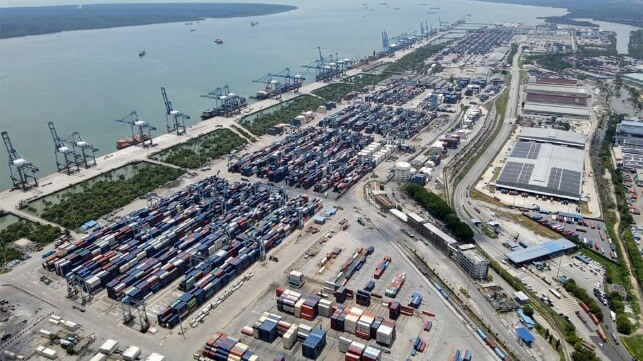Singapore Backlog Spills Over to Malaysia Threatening More Price Increases

Asian ports both in China and Singapore have been struggling for some time with backlogs brought about by containerships diverting from normal routes through the Red Sea and now that congestion is spreading to other regional ports. New reports highlight that with the problem approaching levels seen during the pandemic in 2020 and 2021, delays are increasingly likely along with price increases for shipping and consumer goods.
Singapore-based analysts Linerlytica continue to highlight two hotspots for port congestion. One remains around China’s Shanghai/Ningbo port complexes while the other emerged around Singapore and now is spreading to neighboring Port Klang in Malaysia. While an important regional port close to the capital city of Kuala Lumpur, Bloomberg reports that it is rare for long queues of vessels to form at the port. Last year, the Port Klang Authority said the port handled over 14 million TEU.
In a new report, Bloomberg calculates there are around 20 containerships anchored off Port Klang waiting for berths. Linerlytica’s hotspot scoreboard shows Port Klang with the third highest queue-to-berth ratio (1.15) and they calculate that nearly 84,000 TEU are waiting in the anchorage. Shanghai/Ningbo has a ratio of 1.25 while Singapore has a ratio of .5 according to Linerlytica’s data. They report that there is a total of 32 ships at anchor off Port Klang compared to 28 for the much larger container operation in Singapore.
Analysts told Bloomberg the congestion problems could continue at least through August. That is typically when the high season for Asian container shipping begins as retailers build inventories in advance of the end-of-year holiday sales.
Singapore officials recently highlighted that the issue is due to the ongoing diversions related to the problems in the Red Sea. They said approximately 90 percent of containerships are arriving off schedule resulting in vessel bunching. Carriers they said are increasingly using Singapore as a transshipment port with the Financial Times citing as an example a report from Maersk that it would skip two westbound sailings from China and South Korea due to congestion and delays. Singapore officials also said that containerships are spending more time on berth to rearrange loads to create greater efficiency downstream at later port calls.
The Financial Times in its reporting highlights that with Singapore connecting to 600 ports in 123 countries it influences global operations. Citing the domino effect of the congestion to neighboring ports, they warn that delays will grow. Also, with container prices already at peak levels, they cite analysts predicting capacity delays and demand will drive prices higher.
Maersk issued a report today to customers discussing what it titled the “ongoing ripple effects of Red Sea shipping disruptions.” They are advising shippers to diversify supply chains citing reports that available container capacity was down between 15 and 20 percent in the second quarter of 2024.
Maersk warns that the ongoing situation has increased uncertainty for global supply chains, while extended transit times and port congestion have significantly affected reliability. Maersk highlights that “No one knows how long it will take for the effects of Red Sea shipping disruptions to ease, and how long a return to ‘normal’ could take.”
No comments:
Post a Comment